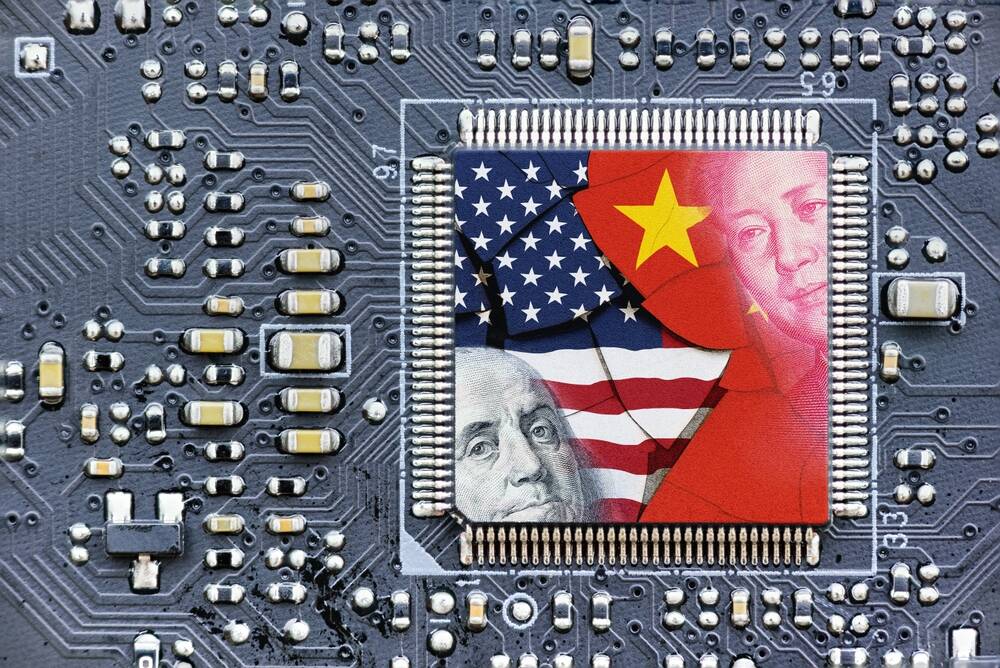Uncle Sam Is This Keen To Keep US CHIPS Funds Out Of China

The Biden Administration on Friday said it had finalized guardrails to ensure payouts from the $50 billion CHIPS Act don't flow into the hands of the Chinese or into any other country or company of concern.
That CHIPS Act money comes from the American taxpayer, and it is supposed to be allocated to corporations so they can ramp up the United States' domestic semiconductor production and reduce the nation's reliance on other parts of the world for the supply of components. Ie, not help other countries, particularly China and Russia, improve their factories and industries.
In a statement, US Commerce Secretary Gina Raimondo emphasized these safeguards were about protecting US interests: "Chips for America is fundamentally a national security initiative, and these guardrails will ensure companies receiving US government funds do not undermine our national security."
The conditions CHIPS subsidy recipients will have to comply with haven't actually changed that much since the Commerce Department first disclosed them in February.
Broadly speaking, CHIPS funds must be invested in the US. Recipients are also barred from investing in most semiconductor manufacturing in countries of concern — primarily China and Russia — and from engaging in joint research efforts or technology licensing with those nations for a period of 10 years. Companies that violate these rules are subject to a claw-back provision.
The changes that have been made clarify what investments are and aren't allowed. For example, the rules now more clearly state that expanded semiconductor manufacturing capacity means addition cleanroom areas and other physical space. That is to say, you can't claim a handout from Uncle Sam to increase output capacity and not actually do any physical expansion. The US government wants to see the money being used so that there's little or no worry that any of it is being quietly funneled off into unrelated work or projects in China and the like.
CHIPS fund recipients with advanced chip facilities in China and other countries of concern can only expand their operational capacities by five percent during the 10-year period. Meanwhile, legacy facilities enjoy a little more leeway, allowing for a 10 percent expansion in capacity tops. According to the Department of Commerce, this is to allow some fluctuation in capacity as a result of equipment upgrades or improvements to operation efficiency.
To ensure compliance, the agency says it will put processes in place to keep tabs on subsidy recipients and ensure nobody is playing fast and loose with the rules.
- The clock is ticking and Korea wants to know if its chipmakers will get their export license extension
- US DoD serves up $238M Chips Act funding to 8 regional hubs
- TSMC gobbles up $430M slice of Intel's IMS Nanofab unit
- So what if China has 7nm chips now, there's no Huawei it can make them 'at scale'
While some additional capacity overseas will be tolerated, certain technologies, particularly those with military applications are still restricted. This includes "current generation and mature-node chips used for quantum computing, in radiation-intensive environments, and for other specialized military capabilities."
Many chipmakers vying for CHIPS funds, including Samsung and SK Hynix, have existing investments in Chinese manufacturing likely to be restricted if they take the cash. The department specifically highlighted its engagements with The Republic of Korea.
In making these changes, the Commerce Department says it "reviewed and incorporated suggestions from stakeholders, including representatives of the domestic and foreign semiconductor industry, academia, labor organizations, trade associations, and others."
As of mid-August, the US Commerce Department said 460 companies across 42 states had expressed interest in CHIPS funds.
GlobalFoundries scores $3B DoD contract
On the topic of safeguarding the US semiconductor supply chain, the Department of Defense (DoD) Thursday renewed its contract with GlobalFoundries for another 10 years.
Under the deal, GF will manufacture "American-made" semiconductors for use in a variety of aerospace and defense applications. Over the life of the contract, GF will be eligible for up to $3.1 billion in defense spending, but not all at once. So far, GF has only been awarded $17.3 million.
In addition to chip production, the contract also grants Pentagon contractors access to the fab's facilities, IP portfolios, and early access to new technologies under development.
The DoD's decision to award GF the contract is by no means surprising. The company is one of the few US fab operators capable of developing large quantities of leading-edge chips. The other is Intel, which routinely develops chips under contract for the DoD's Defense Advanced Research Projects Agency, better known as DARPA, such as this super-threaded graph analytics accelerator demoed at Hotchips. ®
From Chip War To Cloud War: The Next Frontier In Global Tech Competition
The global chip war, characterized by intense competition among nations and corporations for supremacy in semiconductor ... Read more
The High Stakes Of Tech Regulation: Security Risks And Market Dynamics
The influence of tech giants in the global economy continues to grow, raising crucial questions about how to balance sec... Read more
The Tyranny Of Instagram Interiors: Why It's Time To Break Free From Algorithm-Driven Aesthetics
Instagram has become a dominant force in shaping interior design trends, offering a seemingly endless stream of inspirat... Read more
The Data Crunch In AI: Strategies For Sustainability
Exploring solutions to the imminent exhaustion of internet data for AI training.As the artificial intelligence (AI) indu... Read more
Google Abandons Four-Year Effort To Remove Cookies From Chrome Browser
After four years of dedicated effort, Google has decided to abandon its plan to remove third-party cookies from its Chro... Read more
LinkedIn Embraces AI And Gamification To Drive User Engagement And Revenue
In an effort to tackle slowing revenue growth and enhance user engagement, LinkedIn is turning to artificial intelligenc... Read more

